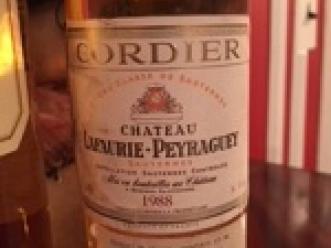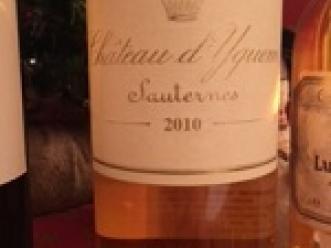In the series on the 1855 Classification of the First Growths, I spoke exclusively about red wines. In that same year, however, the sweet dessert wines from the Bordeaux communes of Barsac and Sauternes were also classified. All of the dessert wines listed were rated as either premier cru (first growth) or second growth status. That is, all but Yquem which was rated Premier Cru Superieur (First Great Growth), a higher rating even than any red wine achieved in their 1855 Classification. Yquem is quite possibly the greatest wine made anywhere and has a history dating back four hundred years! While every wine region has its stars, there is probably no other winery that so dominates the quality of a region and has such as a lofty reputation as Chateau Yquem.
What makes these wines so special is that they develop a rot called botrytis cinera also known as Noble Rot. When certain grapes are attacked they get moldy which, in a wonderful twist of fate, causes the grapes to lose much of their moisture, concentrating the flavors. The resulting grapes look like moldy shriveled raisins that produce a sweet nectar.
Long before grape vines were planted, the property where Yquem sits was owned by Eleanor, Duchess of Aquitaine. When she married Prince Louis Capet (the future King Louis VII) in 1137, the property became part of France. Unfortunately, the marriage was annulled due to adultery. Eleanor re-married Henri Pantagenet (the future King Henry II of England) and the property reverted to English control where it remained until 1453 when at the end of the Hundred Years War, it was ceded to France.
Chateau Yquem was established in 1593 when Jaques de Sauvage exchanged properties with the French Monarchy to obtain Yquem. Under his family’s ownership, the Chateau was built replacing a castle that had sat on the site. A chapel was added in the 16th century. The north wing was added in the 17th century which contains the main reception room. In 1785, Francoise Josephine de Sauvage married Louis Amedee de Lur Saluces (godson of Louis XV). Despite the death of Lur Saluces shortly thereafter in 1788, the property thrived as a wine estate under his wife.
Thomas Jefferson visited the estate proclaiming it France’s best white wine. In 1784, he ordered 250 bottles for his own cellar. Other notables who have waxed poetically about Yquem include Alexandre Dumas, Marcel Proust and Jules Verne. It is likely that the wine they all enjoyed was far different from the wines of today. The extent to which noble rot affected the grapes was left purely to the chance of nature, which meant it existed in some vintage (to a varying degree) and not at all in others. One vintage that was affected was 1811, called the Year of the Comet as Haley’s Comet made an appearance that year. That vintage was one of the most successful efforts at Yquem and probably is still drinking well today!
The property remained in the Lur Saluces family until quite recently. No small feat making it thru the French Revolution, Louis XVI and Napoleon. In 1968, Comte Alexandre de Lur Saluces took over the day-to-day operations. At that time, he was a 7% owner and the family still controlled the Estate. Under his leadership, production was increased as well as a renewed commitment to quality. The Estate was renovated and modernized. In 1996, family squabbles resulted in the sale of a majority of the shares in Yquem to the LVMH (Louis Vuitton – Moet Hennessy) group of France. They bought 55% of Yquem for $100 million. Alexandre de Lur Saluces was still kept as the manager of the Estate. In 2004, Lur Saluces either retired or was forced out depending on whom one believes and replaced by Pierre Lurton. Lurton was a respected name in Bordeaux who ran Cheval Blanc, one of the great wine estates in St. Emilion.
One advantage Lur Saluces enjoyed as owner was that he could fanatically control quality, even at the expense of the bottom line. For instance, entire batches were pulled if they did not meet the vintage standards or on rare occasions, an entire vintage may not have been released if it did not meet the Yquem standards. The last vintage not released was 1992. Also, the wines were released quite late as Lur Saluces did not want to release the wines until they were ready to be consumed. Neither of these practices were suited to the LVMH philosophy of watching the bottom line. Lurton released the 1999 Yquem almost immediately upon taking control. Soon on its heels was the 2001 Yquem which, to the thrill of everyone, may be the best Yquem ever!
Yquem is made in the southern part of Bordeaux, France in the area famous for its sweet wines called Sauternes (part of Graves). The vineyard is very large and sits mostly on top soil with clay subsoil underneath. There are numerous springs on the property and drainage pipes were installed beginning in the 19th century to prevent the roots from becoming waterlogged. There are 457 acres of vineyards; however, only about 80% is in production in a given vintage. Every year some vines are dug up and the earth is left uncultivated for a year before being replanted. It then takes from five to seven years after replanting for the grapes to be good enough for Yquem. About 80% of the vineyards are planted with the white Semillon grape and the balance planted with Sauvignon Blanc. The Sauvignon Blanc is more prolific, so the final blend has nearly equal portions of both grapes. The Semillon provides structure and texture while the Sauvignon Blanc provides lifting aromatics and crispness.
In order to harvest the grapes, the pickers must go out multiple times over the course of weeks, harvesting grape by grape individually. On average, six passes are made thru the vineyard each vintage. Yields are relatively low. If one were to ferment the grapes completely dry, the resultant wine would be almost 20% ABV. The yeasts, however, are not that virile and the fermentation stops at around 13 or 14% ABV leaving the converted sugar behind. The grapes are pressed and transferred to oak barrels where they are aged for about three years. The barrels are racked every three months. At Yquem, due to the low yields and the concentrated juices in the grapes, each vine makes approximately one glass of wine. Obviously, production costs are quite high. Approximately 65,000 bottles are made each year.
The wines are very concentrated, sweet wines with a lightness of being that avoids being cloying with a nice bite of acidity. Yquem is virtually indestructible and well stored bottles can last for as long as you can hold them.
The classic match to any sauternes is fois gras. Personally, I find that Yquem goes wonderfully with some blue cheese at the end of a meal. A friend of mine and Yquem connoisseur, Francois Aufouze, serves it with grilled grapefruit and that is an excellent match as well. Peaches, oranges or apricots will work too.
In terms of vintages to buy, price may be a factor. As was referenced above, the 2001 may be the best Yquem ever. It is still quite young, but is an amazing wine. You can taste it days later. This wine now sells for $500 a bottle or more. Luckily, a 375ml bottle can be found for around $300. Since a little goes a long way, this can be shared by eight or ten people. Other top vintages include the trio of 1988, 1989 and 1990. These are just barely mature now, but will easily last another thirty years. If those are too pricey, the 2004 or 2002 vinatges offer some of the best values and can often be found for under $200 for a full sized bottle or $125 per half bottle. While these are expensive, it really is worth trying once for anyone who wants to experience a wine that is perhaps the greatest wine in the world!
Chateau Yquem also makes a dry white wine called Ygrec also known simply as “Y”. This is made from a combination Semillon and Sauvignon Blanc. Increasingly, it is made from a higher percentage of Sauvignon Blanc. It spends one year in new French Oak before release. The wine still reflects a botrytis character, but it is fermented bone dry. While it is a fine wine, in recent years its pricing has become prohibitive and in my opinion, not worthy of the lofty price tag. There are many fine white, dry Bordeaux wines with lesser names that are more attractive.
I hope everyone does go out and find a way to try a glass of Chateau d’Yquem’s Sauterne. Get some friends together and build a tasting or a meal around it. It really is one of those things in life that is worth trying, at least once. If you do, I would love to hear what you think.



